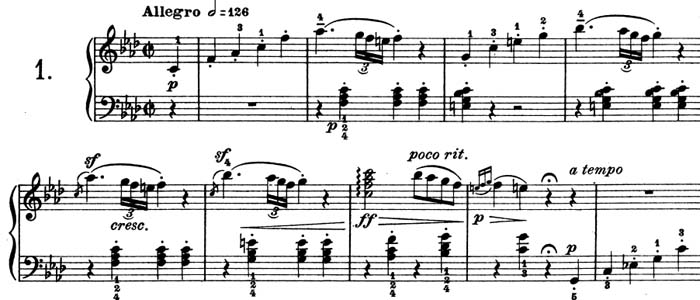Some Characteristics of Beethoven Sonatas

The Beethoven Sound
- Innovative interval spacing
- Using extreme piano registers
- Suggest timbres of other instruments in piano music
- Very varied dynamic changes, often in short time segments
- Sudden accentuation in the weak beats of the measure
The characteristics listed above are always intertwined with each other, when considered separately it helps us to contemplate some of the Beethoven tools. When analyzing any of the techniques, it reveals one or more complementary techniques. In this way, when we concentrate on the space of the intervals, the different dynamics of the musical passage or the different harmonic progressions can also emerge, or perhaps the accentuations and we realize that the whole is what generates the emotional effect. Even so, we insist that isolating each technique is an academic exercise that enhances the sensitivity towards the composer.
Interval spacing
The distance between intervals that Beethoven uses for the emotional part frequently by means of arpeggios and chords at close distances, we call them thick textures. He is one of the very few composers who dares to do it in the low notes. Sometimes I suggest strength, authority, mystery or tragedy.
There are thick textures in almost every movement of the sonatas, the opening of the sonata sets the emotional tone. An example is the beginning of the Sonata No. 8 "Pathétique", it transmits a fatal force due to the density of the first chord. Also in the Largo Mesto-second movement of the Sonata No. 7 we find a deep sadness established by the close distance of the intervals in the D minor chord below the main opening phrase. The suspended opening of the Sonata No. 17 "Tempest" is felt in part due to the harmonic inversion and the intervals in the low notes, with little distance between them and in broken chord. Now, in the high part of the piano we can cite for example the Sonata No. 29 "Hammerklavier", we have complete chords in the upper part of the keyboard giving us a bright effect, of sudden energy.
Beethoven changes the rules of traditional harmony, he changes the distance between intervals far beyond the rules of the moment. Let's think about the opening of the Sonata No. 23 "Appassionata". The rule of traditional harmony is that you should not exceed the distance of one octave between intervals, but here Beethoven doubles it in two octaves in movements Parallels giving us the feeling of mystery, restlessness, anxiety, fear. We can already clearly notice in this sonata these two beings, two heads that we always find in Beethoven music. From bar 16 and the next eight on, we have fast chords, very closely spaced, heavy, in fortíssimo, the two main themes are felt; the reality of life and the human will for survival.
Extreme Registers of the Piano

Example of extreme registers at the piano from Sonata No. 5, second movement.

Example of extreme registers at the piano from Sonata No. 7, second movement.
Beethoven used the extreme ranges of his piano from the earliest sonatas, and as he had more notes available on the instrument, he made use of them immediately, as if he had been waiting for them. We continually see that he wrote a single line in an extreme register, suggesting a timbre associated with some orchestral instruments.
we can find two examples in the second movements of the first sonatas, the Sonata No. 5 and the Sonata No. 7.
The public is emotionally stimulated by the dynamic contrast and ranges in sounds, it generates calm in the midst of the stress of living.
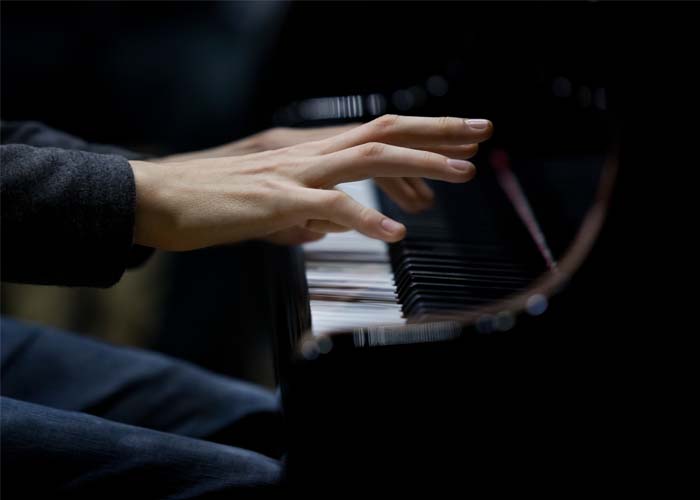
Music Courses
"The genie is made up of 2% talent and 98% constant perseverance." –L. V. Beethoven.
Info and Registration
Another example in the second movement of the Sonata No. 17.
A similar example of using a single texture in a high register occurs at the end of the second movement of the Sonata No. 17. It gives us the effect of the union of two worlds, perhaps the earthly one with another immaterial.

Extraordinary example in the second movement of Sonata No. 32.
A one-of-a-kind passage in music occurs in the second movement of the Sonata No. 32. Beethoven uses two motifs at opposite ends of the piano, where he forces us to pay extreme attention, an effort to contact forces at the very edge of the universe, or perhaps deep within one's consciousness: an agonizing effort to perceive the unfathomable.
Suggest timbres from other instruments in music for piano
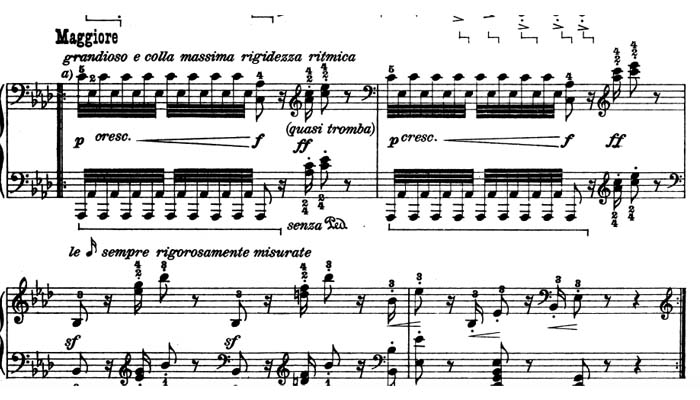
Example in Sonata No. 12, third movement, on the suggestion of other instrument timbres in piano music.
The examples of the use of extreme registers also serve as instances that suggest other instruments. A monophonic phrase or fragment in a high register can be reminiscent of a flute. Examples influenced by percussion instruments include the tremolo figures imitating drum rolls in the funeral march trio in the Sonata No. 12; the suggestion of low rolls in the second movement of the Sonata No. 17 "Tempest", creating here an ominous undercurrent that accentuates the choral texture played by the right hand from measure 17; the percussion-like impulse of the re-exposure at the end of the development section of Sonata No. 21 "Waldstein", first movement , from measure 142, a block of energy that generates an almost unbearable tension for the beginning of the recapitulation. The sforzando chords in the coda of the last movement of the Sonata No. 23 "Appassionata" starting at bars 308 and continuing on to the next nine, pushing with overwhelming sonorities, creating fascinating punctuation that interrupts and activates energy where it seems to come from deep within.
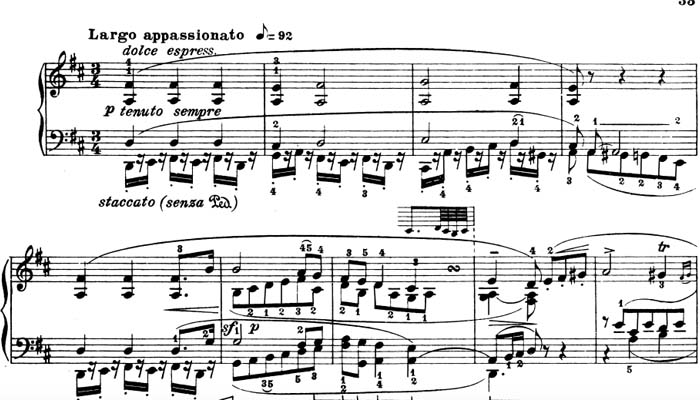
Example of the suggestion of different timbres of other intruments at the piano in the second movement of the Sonata No. 2.
One of the most fascinating imitations of Beethoven is that of the pizzicato strings. Bass accompaniment figures marked in staccato to aid the opening of the second movement of the Sonata No. 2, the central theme in the slow movement of the Sonata No. 4 "Grand Sonata", from measure 25 and the following 13, and the second movement of the Sonata No. 15 "Pastoral".
The same texture is applied in a quick adjustment to the second movement, scherzo of the Sonata No. 18 "The Hunt", starting at the first measure. In these textures that should sound like pizzicati, the use of the pedal should be avoided as the effect of the staccato marks is not compromised.
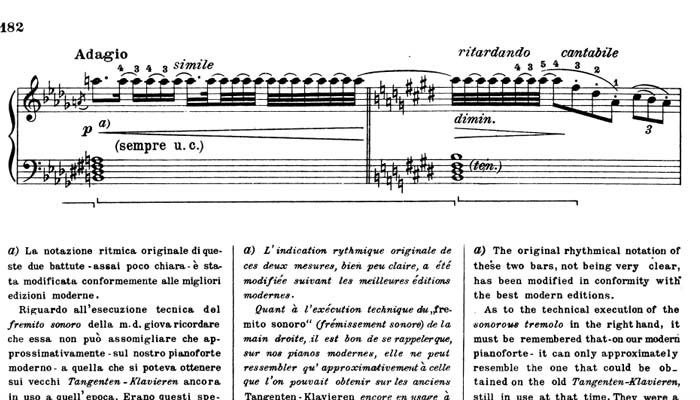
Example in the second movement of the Sonata 31.
In the slow movements of the Sonata No. 29 "Hammerklavier" and the Sonata No. 31, Beethoven gives us puzzling passages. In the two sonatas, the composer tied repeated notes in pairs, but also indicated fingering changes because each of the pairs is tied, why ask the players to change fingers each time?
Some musicians believe that the composer was trying to imitate a vibrato technique. This vibrato is possible on the harpsichord, for the metal tangent that rests slightly against the string can be moved by increasing and decreasing the pressure of the finger on the key. This delicate effect was appreciated by those who loved the sweet and sensitive sound of the harpsichord. Beethoven then indicates contemplative improvisational scenarios, underlining intimacy, suggesting the state of expectation in meditation that seeks answers or revelations.
Extreme dynamic changes, very frequently found within short time segments
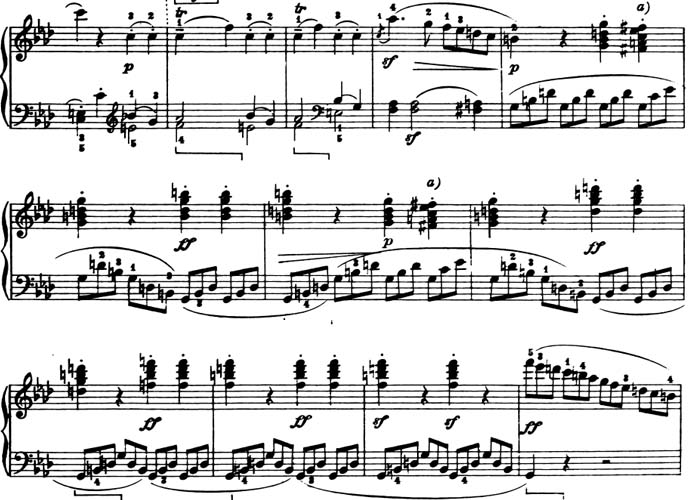
The use of different timbres in piano music, example taken from Sonata No. 1, third movement.
Throughout the 18th and early 19th centuries, composers must have found delight in the dynamic flexibility offered by the newly developed fortepiano. Haydn already occupied express annotations for the use of the different volumes on the piano (p) and forte (f) instrument. Beethoven extended the use of such dynamic contrast immediately. In a short time, the novelty of wearing a key instrument capable of performing different dynamics and contrasts led to the beginning of considering the piano as a substitute for the orchestra, reducing salary costs and increasing profits for theater entrepreneurs. With Beethoven we see that each time, in each new work, the textures of his piano are more and more reminiscent of orchestral tones.
The beginning of the last movement of the Sonata No. 1, is a first example with Beethoven. The change in dynamics between piano and forte, combined with the richness of the full chords in the right hand, creates surprising and dramatic flashes of color, only found in orchestra or in your substitute, the piano. For the listener, attention stops with unexpected changes and an alert expectation is generated. The effect intensifies a few bars later, starting at 13, where the range of contrast is broadened, now from piano to fortissimo. This passage suggests a stubborn insistence, for all those Beethoven lovers, they will know that it is the main characteristic of the composer.
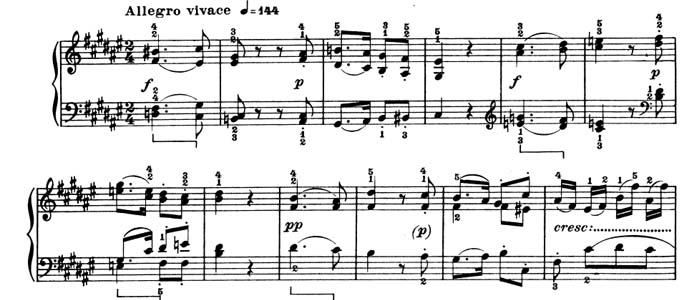
Example of dynamic contrast between the motifs from the second movement of the Sonata No. 24 "A Thérèse".
We can find another early example in the middle section of the second movement of the Sonata No. 3, starting from bar 26, where the The contrast between piano and fortíssimo is used not only for drama, but also to emphasize structural units.
In the second movement of the Sonata No. 24 "A Thérèse" there is a strong dynamic contrast between the motifs, in this way highlights the structure; surprise and playfulness.
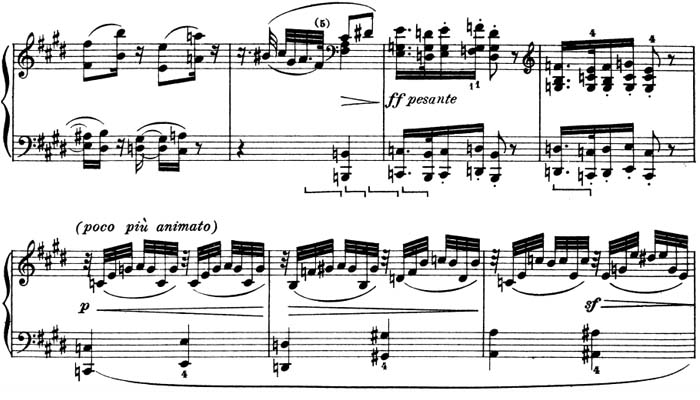
Fragment of the second movement of the Sonata 3.
Sudden dynamic changes are often used in conjunction with surprising harmonic changes. An example of this combination occurs in the second movement of the Sonata No. 3, where the intrusive surprise of the C major in an E major the passage is reinforced by the sudden onset of a dynamic in fortíssimo. Here we musically relive the unexpected intrusions of life, in this case powerful enough to claim our full attention, but ultimately, it doesn't seem threatening.
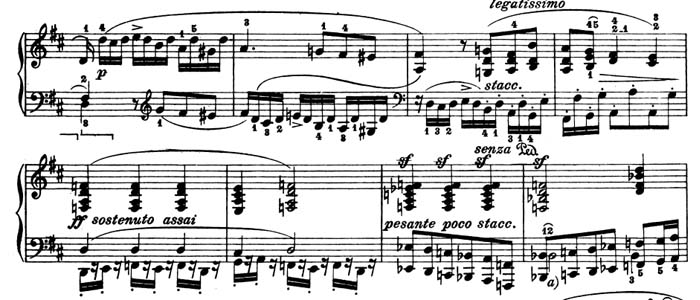
Examples of the volume changes in the second movement of the Sonata No. 2.
Three surprising techniques are combined in the second movement of the Sonata No. 2 where an unexpected coda-like section is announced with a fortíssimo sudden and a change from D major to D minor. This passage arrives at a strategic point in the structure, a point at which we are just prepared to hear the final resolution in D major of the movement.
Accentuation, often suddenly and in weak times
In the exposition of the first movement of the Sonata No. 1, Beethoven sets the stage for a para get to sforzandi. Here the accents are integrated first and second theme.
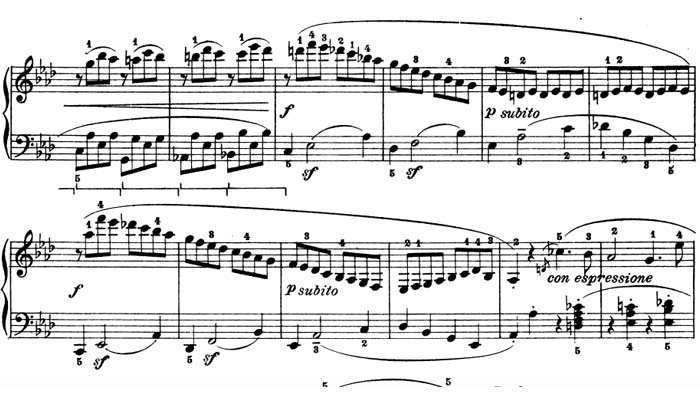
One more example of the accents in the Sonata No. 1.
The extravagant syncopated accents on the bass line at the climax of the show put the listener to the limit and surely must have generated sounds at the time that might have seemed rude to contemporary Beethoven.
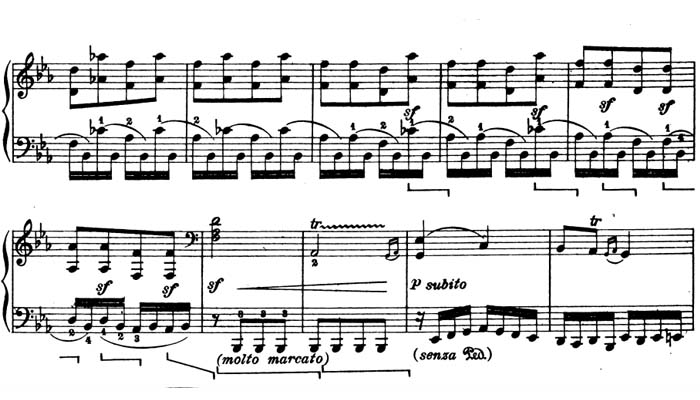
Example of accentuated syncopation in Sonata 13.
There are many similar examples in the work of Beethoven where the accentuated syncopation to break the rhythm reaches the point where the listener loses the strong beats, the ground.
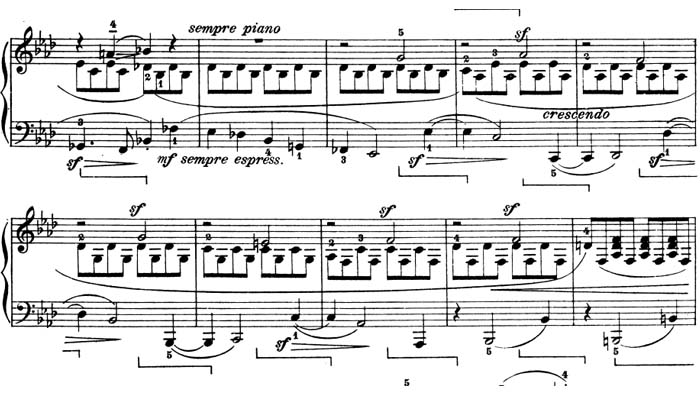
Development section of the first movement of the Sonata No. 1, complex accents in patterns of different levels.
Often times, these accents form a pattern that cuts across the voice levels and uses much of the piano's compass. Note the complexity of the pattern presented in the development section of the first movement of the Sonata No. 1, a passage that suggests that emotion and complexity often go together.
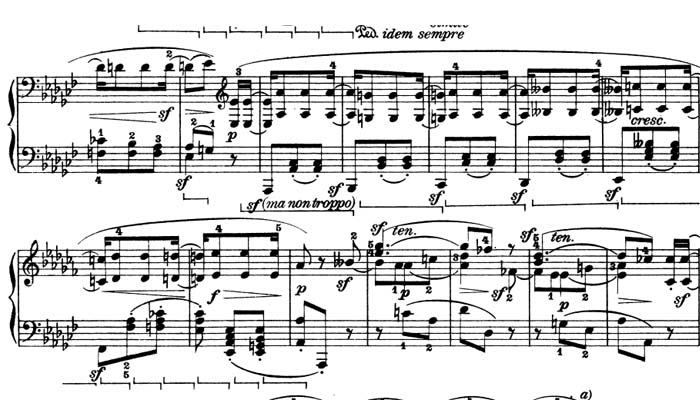
Example of sforzandi in the Sonata 12 "Funeral March".
Near the end of the fugue in the last movement of the Sonata No. 28, Beethoven usa < em>sforzandi in an increasingly tight sequence to strengthen the power of the dominant seventh arpeggio that will lead us to the recapitulation of the movement. How step by step do we feel the pressure approaching us as we get strategic junctures in our lives?
Many sforzandi have sinister implications. In the first movement of the Sonata No. 12 "Funeral March", the third variation is in the relative minor minor, and the sforzandi that support its static and syncopated line pricks us like the recurrence of painful or frightening patterns.
This variation is linked to the tragic funeral march, third movement of the sonata, both in A♭ minor, a key that visually suggests thorns as it shows its seven floors.

Example of the syncopated accent in the second movement of the Sonata No. 17 "The Tempest".
The subtle and threatening inevitability is felt in the second movement of Sonata No. 17 "The Tempest", as the aforementioned drum roll figuration is combined with syncopated accentuation.

Example of sforzando in Sonata 29.
The extreme range and the repetition of the trills marked the sforzando in the fugue of the Sonata No. 29 "Hammerklavier" project an aggressiveness that represents the raw frustration and anger that all human beings suffer in some time in life.
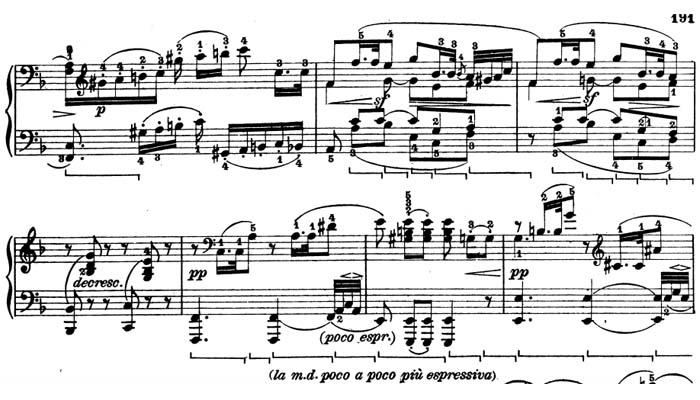
Example of sforzando as structure delineator in Sonata No. 21 "Waldstein".
Beethoven used the sforzando to outline the structure of the phrase in the introduction section to the last movement of the Sonata No. 21 "Waldstein".
The sforzando in the final note of measure 14 may seem awkward until it is perceived as an upbeat beat for the phrase that begins at the downbeat of measure 15.
Musical structures and patterns related to the tone
One of the most effective ways Beethoven elicited an emotional response was by using innovative relationships with tone. When we compare Beethoven 's tonality manipulation with that of his less gifted contemporaries, we are struck by the intensity and fluidity of his use of the keys. Also, carefully and frequently plan unusual passing harmonies for the musical color. To generate such color he involved such techniques as a change between the major and minor, transitory parallel use of voices taken from other tones, passing to Neapolitan harmonies for several bars, and the use of augmented sixth harmonies.
Beethoven planned the overall tonality of each work with unusual care, relating any available tone to a hierarchy of larger units, and finally formulating a conceptual scheme that encompassed passages, sections, movements, and whole works. Within this framework, he seemed to enjoy adding surprise modulations, arrivals on keys that seem far removed from the home key, and, at times, an almost obsessive prolongation of the dominant tension before resolution. One can imagine Beethoven mischievous delight in brandishing the unexpected, teasing, and playing games to delight, or frustrate listeners.
Changing the expected hue is even more remarkable for its effectiveness two hundred years after conception. Performers and audiences continue to react to the drama of Beethoven 's sonority conflicts, the freshness of his modulations and the humor of his mockery. Thus, with each unfolding of flat sound, we share the turbulence of his emotional life, laugh at his musical joke, and follow his ascent to ethereal realms.
As mentioned above, isolating and analyzing Beethoven's genius can seem to dull the brilliance of his creativity. Still, a close inspection of examples generates a greater depth of appreciation. Also, after analysis, the wonder returns with greater intensity as we move away from detail and respond again to the emotional content of the music. Many of the examples noted here are also highlighted later in the context of each sonata.
Changing the concept of multiple movements in piano sonatas
Beethoven expanded the concept of the piano sonata by adding a dance movement between the slow movement and the ending movement. The typical pattern in Haydn and Mozart piano sonatas consisted of three movements, fast-slow-fast. There are exceptions to this pattern, such as some two-sonata movements and early Haydn sonatas with multiple suite-like movements. Beethoven 's intention to add the fourth movement was clear. His four-movement pattern was modeled after the great concert works, thus equating the importance of the piano sonata to that of the symphony, the string quartet, and other works. Beethoven made a strong case in favor of this concept, for the first four piano sonatas are four-movement works.
However, Beethoven did not abandon the traditional three-movement sonata. These tend to be divided into two types; the first with lighter works and several of them a little less dramatic, such as Sonata No. 5 "Little Pathétique", Sonata No. 6, Sonata No. 9, Sonata No. 10 and the Sonata No. 25 "Cuckoo".
These sonatas have their individual challenges and charms, and are often among the first Beethoven sonatas recommended by teachers to their students.
The second type of three-movement sonata could be called dramatic. This type encompasses the most popular sonatas, all with nicknames, the Sonata No. 8 "Pathétique", Sonata No. 14 Moonlight, Sonata No. 17 The Tempest, Sonata No. 21 Waldstein, Sonata No. 23 Appassionata and the Sonata No. 26 Les adieux. Three other works with three movements do not fall into any of the categories: the Sonata No. 16, the Sonata No. 30 and Sonata No. 31.
As Haydn and Mozart did at the time, Beethoven also occasionally wrote two-movement sonatas, many of which have shorter movements; the Sonata No. 19 and Sonata No. 20 from the time of its publication were demonized as Easy Sonatas Leichte Sonata. Other two-movement sonatas; Sonata No. 22, Sonata No. 24 A Thérèse and the Sonata No. 27 are more challenging but keep a compact format. The last two-movement sonata, which is also the last of all the ones Beethoven wrote, is the Sonata No. 32, It is among the most difficult works of the piano repertoire, both in the emotional part and in the piano technique part.
Having adapted the four-movement pattern for the piano sonata, Beethoven made several changes. The first was to replace the scherzo with the minuet and the trio. This change appears first in the sonatas No. 2 and No. 3. The second change was to add an additional move that is related to the minuet or scherzo but designated as none, often using just a tempo flag. In these cases, the music itself does not usually dance or joke, although most of the time it generally conforms to the structure of the minuet and the trio. Movements of this type appear in Sonata No. 4 Grand Sonata, Sonata No. 6, Sonata No. 13 Quasi una fantasia, Sonata No. 28 and Sonata No. 31, the last two preserving the structure but changing the metric to duplicate.
Beethoven instituted one of his most influential changes to the Sonata No. 12 Funeral March. Solidifying the concept of the four-movement sonata, he decided to interchange the positions of the two internal movements, making the fast movement the second and the slow movement the third. This concept worked well, for Beethoven the lightness and brevity of the scherzo provided a wide contrast to the more serious, extended opening movement, and the slow movement was now a focal point that provided maximum contrast with the energy of the final movement. Beethoven continued this pattern with the Sonatas No. 28 and No. 29 Hammerklavier. Later composers obviously found it attractive, because it also appears in the piano sonatas of many later composers; Chopin, Scriabin, Prokofiev and Barber.
Finally, Beethoven changed the traditional role of the final movement of the sonata which was a short and light ending. Haydn and Mozart showed trends toward strengthening the function of the trailing move, but stopped before letting it overshadow the opening move. From the earliest sonatas, Beethoven's final movements were significant in length and in many works was an approximation to the sonata-allegro structure. The final movement of the No. 1, for example, is in sonata-allegro form with a middle section theme in place of the development. The traditional sonata-allegro structures appear in the Sonata No. 5 Little Pathétique, < a href="sonatas/sonata-17.php">Sonata No. 17 The Tempest, Sonata No. 18 The Hunt, Sonata No. 23 Appassionata, Sonata No. 26 Les adieux and Sonata No. 28. Rondo patterns of ABACABA were closely related to the sonata-allegro form, often using B sections that were in the dominant keys and tonic; Sonata No. 2, Sonata No. 3, Sonata No. 4 Grand Sonata, Sonata No. 11 , Sonata No. 15 Pastoral, Sonata No. 16. In other sonatas we find the C sections developed from previous passages; Sonata No. 13 Quasi una fantasia, Sonata No. 16, Sonata No. 23 Appassionata and Sonata Sonata No. 27.
Having placed the first and last movements with almost equal importance, Beethoven takes the next step; conceives the last movement as the focal point of the sonata, minimizing the length and importance of the first movement. This change of emphasis can already be seen in the Sonatas No. 13 Quasi a fantasy and No. 14 Moonlight, where the final movement is the longest in the sonata. And with even more emphasis we can see it in the sonatas No. 28, No. 29 Hammerklavier, No. 30, No. 31 and Sonata No. 32.
Defying expectations in a Sonata-Form
The structure known as the sonata-allegro form, or sonata form, evolved gradually during the 18th century. Incipient examples of it are found in the two baroque dance type structures, as well as the excercisi or sonatas by Domenico Scarlatti (1685-1757). Haydn's personal documents indicate the excitement he felt as the development of thematic material within the context of Sonata expanded and solidified. At the end of the 18th century, a large number of musical works that followed the pattern of Forma Sonata were created by C. P. E. Bach, Haydn and Mozart, as well as many less famous composers. The structure conceptually flourished throughout the 18th century, but was not formalized into an academic plan until the early 19th century in the writings of Hoffman (1776–1822), Heinrich Birnbach (1793–1879) and Antoine Reicha (1770-1836). Even Carl Czerny was influential in this regard in his School of Practical Composition (1848-1849).
We cannot know the strength of listeners' expectations regarding the structure of the sonata form in the last decade of the 18th century. Was this concept simply a composer's tool, or had it penetrated listeners' minds to the point of generating expectations of key musical events or relationships?
We don't know if Beethoven felt that he was breaking the rules or felt that he was being creative with an idea that was considered malleable. Both Haydn and Mozart experimented with the structure in forms quite similar to the bolder strokes associated primarily with Beethoven. Ergo, the structure had constant revisions in the minds of the great composers long before the theorists froze it.
On the other hand, it is intuited that a certain degree of expectation has been established, that the composers had a conceptual norm against which to project their ideas. It is this standard, with its multiple expectations, that will help us examine Beethoven's creativity, although our observations must be tempered with the understanding that the structure was not as rigid as the examples might show.
Let's review the model:
| Exposition | Development | Recapitulation |
|---|---|---|
| Thematic opening material is indicated in the opening pitch. At some point modulation takes place in the dominant in major tones and the relative major in minor tones, often in conjunction with the start of new thematic material. | Material heard in the exhibition is reworked, using modulation, fragmentation, and extension, often in dramatic gestures. New thematic material is introduced. | Material in the exhibition is repeated. Music first heard in the dominant, in the major tones, or the relative major, in the minor tones. Now comes the start tone. When the sonata is in a minor key, the parallel major is sometimes used. |
One of Beethoven's favorite resources was setting the "wrong" tone for the second subject area of the exhibition. Often it came in with the "wrong" tone and then moved as expected. Such manipulations are similar to the charming little surprises that we experience in life: unexpectedly finding something beautiful, a new taste, a detail of nature or a mellifluous sound. The following diagram shows us to what extent Beethoven used this resource in his first movements.
| Sonata and Key of the first movement | Expected key of the second subject area | Key that Beethoven occupied |
|---|---|---|
| Sonata No. 2: A Major | Dominant: E Major | E minor, then E Major |
| Sonata No. 3: C Major | Dominant: G Major | Two themes; G minor, then G Major |
| Sonata No. 7: D Major | Dominant: A Major | An intervening theme in the submediant (b minor), then A major |
| Sonata No. 8 Pathétique: c minor | Relative Major: E flat Major | E flat minor, then E flat major |
| Sonata No. 16: G Major | Dominant: D Major | Mediant major and minor: B major alternating with b minor |
| Sonata No. 17 The Tempest: d minor | Relative Major: F Major | Minor dominant: A minor |
| Sonata No. 21 Waldstein: C Major | Dominant: G Major | Through Major: E Major |
| Sonata No. 23 Appassionata: f minor | Relative Major: A-flat Major | Both A flat major and A flat minor |
| Sonata No. 27: e minor | Relative Major: G Major | Dominant minor: b minor |
| Sonata No. 29 Hammerklavier: B flat major | Dominant: F Major | Major Submediant: G Major |
| Sonata No. 32: c minor | Relative Major: E flat Major | Submediant Major: A flat Major |
Although the table above refers only to the first movements, we can also talk about the final movements in sonata form. There are four, all in minor, that use the dominant minor in the second thematic area of the exhibition instead of the relative major; Sonata No. 1, Sonata No. 14 Moonlight , Nonata No. 17 The Tempest and the Sonata No. 23 Appassionata.
Two unusual procedures that occur in the Sonata No. 18 The Hunt. The second movement, a scherzo movement in the form of sonata-allegro, is in the key of A♭ major. The second theme of the exhibition opens in F major, continues to B ♭ major, and then closes in the expected E ♭ major. The recapitulation introduces the second theme in G ♭ major, moves to E ♭ major and closes at the opening tone of A ♭ major. The fourth movement of this sonata is in E major. Although its exposure is regular in the sense that it hovers around the dominant, B ♭ major, the recap presents an unexpected modulation to E minor at the optimistic beat at bar 200, and as the material for the second theme enters, it moves between G ♭ major and E ♭ minor until the ending begins at measure 263. The starting pitch is restored throughout the long ending. Thus, Beethoven established a subtle link between the second and fourth movement recapitulations of this work.
In addition to the unexpected tones, Beethoven used techniques that create a sense of development and drama before the exhibition draws to a close. Shortly after the listener reaches a second theme of the exhibition, something dramatic begins, reminding us once again of the moments in our lives when unexpected events overtake us. In those moments, we feel urgency, we get involved and, many times, we must initiate action. Beethoven draws our attention in a similar way. These resources are used in first moves as follows:
Expanding the exhibition with passages
- Sonata No. 2
- Sonata No. 3
- Sonata No. 4 Grand Sonata
- Sonata No. 7
- Sonata No. 8 Pathétique
- Sonata No. 11
- Sonata No. 15 Pastoral
- Sonata No. 16
- Sonata No. 17 The Tempest
- Sonata No. 18 The Hunt
- Sonata No. 21 Wldstein
- Sonata No. 23 Appassionata
- Sonata No. 29 Hammerklavier
- Sonata No. 32
Modulating to unexpected tones after the entry of the second theme
Repeat part of the opening theme before the end of the presentation
- Sonata No. 2
- Sonata No. 5 Little Pathétique
- Sonata No. 9
- Sonata No. 11
- Sonata No. 16
- Sonata No. 25 Cuckoo
- Sonata No. 26 Les Adieux
- Sonata No. 29 Hammerklavier
- Sonata No. 32
The use of a tone other than the tonic at the arrival of the recapitulation does not occur frequently in sonatas. Rather, Beethoven preferred to create suspense before the recap and uses the arrival of the opening tone as a dramatic event. However, there is a notable example of false recapitulation, the first movement of the Sonata No. 6, a movement in F higher. The general spirit of the movement is one of joviality. Beethoven 's intention was obviously humorous when he proposed a D minor tonal center with almost painful deliberation at the end of the development section at bars 113 and the next three. Then the first theme appears in the parallel key of D major at the optimistic beat in bars 118 and the next eleven at the beginning of the recapitulation. Skillful modulation beginning at upbeat bar 131 and the next five, highlighted by breaks, as well as a reiteration of celebration of a motif drawn from the opening theme, brings the movement back to its opening pitch.
Beethoven frequently alters the utterance of the first theme in recapitulations in ways that do not involve tonality. More frequently I changed the dynamic level, range, or display of the recap reformulation to increase its intensity. The listener feels a sense of security, elation, or excitement when arriving home after the turbulence of development. Such feelings, encountered upon returning to familiar territory, resonate with our experiences in life. The following table shows the first movements in which this technique is used.
| First Movement of the Sonata | First theme in the exposition | First topic in the recapitulation |
|---|---|---|
| Sonata No. 1 | piano | forte plus added sforzandi |
| Sonata No. 2 | piano | forte |
| Sonata No. 4 Gran Sonata | piano | fortíssimo plus a fuller opening chord |
| Sonata No. 9 | piano | forte plus fuller chords and left hand scales |
| Sonata No. 16 | piano | forte |
| Sonata No. 17 The Tempest | piano | The theme is interspersed with passages of soft recitatives along pedal markings |
| Sonata No. 23 Appassionata | pianíssimo | Pedal with repeating note |
| Sonata No. 28 | No volume mark, crescendo-diminuendo signs in the first sentence | |
| Sonata No. 29 Hammerklavier | fortíssimo | fortíssimo and changes in the left hand |
| Sonata No. 30 | piano dolce | forte and the left hand rewritten |
| Sonata No. 31 | piano sanft | Increased activity in the left hand and expansion of sonorities in the right hand |
| Sonata No. 32 | single notes | Octaves plus a more widespread range |
Starting movements with conflicts or ambivalent sounds
In the early sonatas, Beethoven fulfilled the expectation of establishing the main tone of the work clearly in the opening bars. Thus, in all sonatas through the No. 14 moonlight, the initial notes of the first movement are based on the tonic harmony, here are some examples with the tonic chord:
- Sonata No. 3
- Sonata No. 4 Grand Sonata
- Sonata No. 5
- Sonata No. 8 Pathétique
- Sonata No. 9
- Sonata No. 11
- Sonata No. 12 Funeral March
- Sonata No. 13 Quasi una fantasia
Example with figuration that suggests tonic harmony:
The tonic remains stable during the opening statement of the opening theme.
Beginning with the Spnata No. 15 Pastoral, Beethoven entered a period of composition in the that several sonatas open with conflicting or ambivalent sounds. This impulse started modestly, but grew bolder as the concept grew in the composer's mind. He used it most often in sonatas written between 1802 and 1805 and only occasionally in the remaining sonatas. The following list summarizes this feature:
- The Sonata No. 15 Pastoral opens with a major-minor seventh chord that functions as a secondary-dominant to the subdominant of the main key of the sonata in D major.
- Sonata No. 16 opens clearly in the opening key of G major, but the opening theme is immediately repeated one step lower in the key of F major.
- Sonata No. 17 The Tempest opens on the first inversion of the dominant.
- Sonata No. 18 The Hunt opens at the first inversion of the seventh supertonic. The opening of the sound moves chromatically through a diminished seventh loudness to arrive solidly at a tonic six to four chord, after which the starting tone is introduced. The progression is so amazing that the composer uses it extensively throughout the first movement.
- Sonata No. 21 Waldstein opens clearly in its opening tone, C major, but the opening theme is immediately repeated one step lower in the key of B♭ major.
- Sonata No. 23 Appassionata starts in F minor, but the opening theme is immediately repeated a semitone higher and with a mode change in G ♭ major. The conflicts inherent in this half-step interval are reflected in a motif that makes use of the semitone between the sixth degree of the minor scale and the fifth degree from measure 10.
- Sonata No. 26 Les Adieux opens at the opening tone of E♭ major, but the opening motif makes use of of a misleading resolution and ends with a decreased C minor loudness.
- Sonata No. 28 begins with the dominant of the opening tone, A major. So, through a series of deceptive cadences, he never reaches the tonic but rather moves to the second subject area in the expected dominant, E major.
- Sonata No. 32 begins with a diminished seventh that resolves to the dominant of the opening tone, C minor.
Beethoven showed a decided preference for initiating other movements of his piano sonatas on tonic harmonies. The middle movements may be written in tones that are different from the opening tone of the play, but the movements themselves generally begin with their tonic. This is especially true of slow movements, one could speculate that the composer felt that the mood of the slow movement, whether contemplative or rested, is best conveyed by the stability achieved by the tonic voicing with the movement's first strong beat.
Even so, there are some exceptions. The clearest of these is the adage section of the Sonata No. 28, it is interesting that Beethoven wrote Sehnsuchsvol (longing , longing) at the beginning of this movement, a sentiment he established by writing a first inversion of a dominant seventh voicing in the opening measure. The listener feels the pain of reaching out to reach out, the uneasiness of wanting a resolution.
In the Sonata No. 21 Waldstein the slow introduction to the ending movement affirms its beginning, F major, becomes the base on the to build a sixth chord, which is then resolved in E major. The ambiguity of the tone increases, the feeling of mystery, expectation, as if waiting for the first light of dawn.
Likewise, the initial loudness of the second movement of the Sonata No. 26 Les Adieux could be a skeletal outline of the tonic, C minor, but immediately emerges as a seventh chord decline that acts like VII7 to the dominant of the starting tone. Here Beethoven provides the panorama, that of loneliness caused by the absence of a loved one.
Dance movements, whether they be minuets or scherzos, influenced Beethoven to write music with opening sounds that he needed to advance to resolve.
| Sonata | Movement | Opening Harmony |
|---|---|---|
| Sonata No. 1 | Menuetto | The first beat of the measure is supertonic. |
| Sonata No. 3 | Scherzo | The first full measure features a non-scalar tonic movement. |
| Sonata No. 12 | Scherzo | The first beat of the first measure is the submediant. |
| Sonata No. 14 | Allegretto | The first four bars are a function of the dominant. |
| Sonata No. 20 | Tempo di Menuetto | The first full measure is in dominant harmony. |
| Sonata No. 29 | Scherzo | The first beat of the first full measure is dominant. |
Closing movements that open with non-tonic harmony include those with a gentle and graceful spirit, as well as those with boisterous vigor.
| Sonata | Movement and Mood | Opening Harmony |
|---|---|---|
| Sonata No. 4 | 4º: poco allegretto e gracioso | | Graceful flex |
| Sonata No. 5 | 3º: prestissimo | Vigor and abruptness | The opening is in unison lines, which implies a harmonic progression from VII to I in the first two measures. |
| Sonata No. 12 | 4º: Allegro | Cheerful energy | The right hand figuration describes parallel chords that lead to dominant harmony without clarity resolution up to measure 12. |
| Sonata No. 16 | 3º: Allegretto | Sweetness, joy, with a pastoral feeling | Although the first measure seems ambiguous, later harmonization points to the dominant harmony that is translated to the tonic at measure 2. |
| Sonata No. 24 | 2º: allegro vivace | Boisterous fun | The opening motif features a jarring sixth rise that moves to a dominant on its third inversion in the first two bars. The short phrases continue to end with dominant or subdominant voices that delay the arrival of the tonic until measure No. 12. |
Notable improvisational sections are produced in the Sonata No. 29 Hammerklavier and the Sonata No. 31. Each sets the stage for the climactic finale of the play of which it is a part. In the Sonata No. 29 Hammerklavier improvisation leads directly to a monumental fugue. In Sonata No. 31 the improvisation precedes a multi-section ending composed of arioso slow statements that alternate with a fugue that evolves into a climatic section, presenting an quasi-orchestral statement of its theme. These improvisations move from one key to another seemingly at random.
In the first movement of the Sonata No. 29 Hammerklavier it seems to take material for the final movement of the work, moving through of possible themes or passages in G and B major, G minor and A major. Then an impressive arrival of the dominant of the opening tone of the sonata marks the beginning of the fugue. Beethoven masterfully builds great anticipation in the listener through changes in tone and rhythmic vitality. Capture the excitement we feel when an event that we have waited for in our lives is about to happen.
The recitatives of the Sonata No. 31 move in a different direction. Its purpose is to calm us down before embarking on a journey that leads through despair to triumph. Opening in B♭ minor, its objective is to take us to the key of the ♭ minor of the arious. There is cadence there, but then the composer deviates, suspending us with a dominant seventh that resolves to the external key of E major. However, that sound is also that of the submediant in A♭ minor, so with a skillful use of diminished seventh harmonies, Beethoven effortlessly brings us to the tone of meditation. This journey could well reflect the meditative experience in life in which the mind seems to be drifting into strange realms just before slipping into deep concentration.
Use of dominant sounds or similar to the dominant ones
Exploiting the tension between tonic and dominant sounds was commonplace in Beethoven's time, he was able to infuse this relationship with such extraordinary power is a testament to his genius. The composer used it in several different ways. First, he used the prolongation of the dominant or dominant-like harmony to create tension, forcing the listener to wait for a resolution for periods of time. This sustained dominant function is frequently found in a context of driving excitement, creating intense expectation, but it also appears, although less frequently, in softer settings, creating the sensation of moving toward resolution like a falling feather or floating leaves. . It appears most often in passages that move toward reformulations of main themes, such as recapitulations or reappearances of the main theme in a rondo. The clearest examples of this technique tend to be found in sonatas of the middle period.
| Sonata | Movement | Measures | Sets Up | Texture |
|---|---|---|---|---|
| Sonata No. 11 | 1º | 113-126 | Recapitulation | Dominant seventh and diminished ninth in broken chords that unfold over longer phrases for the left hand |
| Sonata No. 15 Pastoral | 4º | 101-113 | Return of the A tone in a rondo pattern | Dominant pedal point over broken chords and worked passage, all to be played in fortissimo |
| Sonata No. 16 | 1º | 162-192 | Recapitulation | Dominant seventh and diminished ninth in arpeggio figurations |
| Sonata No. 17 The Tempest | 3º | 199-214 | Recapitulation | Figuration in dominant novenas |
| Sonata No. 21 Waldstein | 1º | 142-155 | Recapitulation | An ostinato pattern based on the left-hand dominant supports the right-hand lift in fragments through a crescendo |
| Sonata No. 21 Waldstein | 3º | 287-312 | Return of A in a rondo pattern | Smooth figuration of dominant harmony with a diminished ninth |
| Sonata No. 21 Waldstein | 3º | 378-402 | The coda marked as prestíssimo | Powerful fortissimo on dominant chords rising and falling back in a diminished ninth |
| Sonata No. 23 Appassionata | 1º | 123-134 | Recapitulation | Cadence shines in seventh patterns sweeping across the keyboard to reach a pedal-powered dominant. |
| Sonata No. 23 Appassionata | 3º | 184-211 | Recapitulation | Smooth seventh arpeggio snippets slowing down momentum |
| Sonata No. 24 A Thérèse | 2º | 23-31 | Return to A in a rondo pattern | Double note figures built on dominant harmony |
| Sonata No. 24 A Thérèse | 2º | 74-88 | Return to A in a rondo pattern | Dominant seventh loudness in the G tone functioning as an augmented sixth chord |
| Sonata No. 24 A Thérèse | 2º | 133-149 | Return to A in a rondo pattern | Dominant seventh loudness in the D Key functioning as an augmented sixth chord |
Another way that Beethoven uses the tonic-dominant relationships is by rapidly alternating the two voices to create tension in the following instances.
- Sonata No. 1, 4th movement, Prestíssimo, opening theme
- Sonata No. 23 Appassionata, 3rd movement, Prestíssimo, measures 308 to 325
One of the areas in which Beethoven showed great ingenuity typically occurs just after the first theme is enunciated in the recapitulation of a sonata-allegro movement.
Traditional structure guidelines require that all recapitulation remain in tonic. Beethoven frequently deviated from the tonic right after the first theme was set. He briefly introduced unexpected tones so that he could modulate the tonic as the second subject area appeared. You could call this short excursion a change of course. Most of the time it was based on material from the first theme. It could be elaborate or barely noticeable. Beethoven's use of it is reasonably consistent. The following list points to the most obvious uses for this technique.
| Sonata | Movement and Home Key | Measures | Key used for recapitulation |
|---|---|---|---|
| Sonata No. 1 | 1º | f minor | 111-119 | b♭ minor |
| Sonata No. 2 | 1º | A Major | 244-247 | D Mayor |
| Sonata No. 3 | 1º | C Major | 147-155 | C major, F major, D major |
| Sonata No. 4 Grand Sonata | 1º | E♭ major | 205-214 | A♭ Major |
| Sonata No. 5 Little Pathétique | 1º | c minor | 191– 232 | G♭ major, e♭ minor to 2nd theme in F major, then restated in c minor |
| Sonata No. 5 Little Pathétique | 3º | c minor | 73-85 | 2nd theme in C major, then material in C minor |
| Sonata No. 6 | 1º | F major | 153-162 | f minor, E♭ major, A♭ major |
| Sonata No. 8 Pathétique | 1º | c minor | 207-237 | D♭ major, e♭ minor, f minor to 2nd theme in f minor, then restated in c minor |
| Sonata No. 9 | 1º | E major | 103-106 | C major |
| Sonata No. 11 | 1º | B♭ major | 139-146 | B♭ major, c minor; then sequential chords with secondary dominant upbeats |
| Sonata No. 17 | 1º | d minor | 159-171 | f♯ minor, g minor |
| Sonata No. 17 | 3º | d minor | 243-271 | b♭ minor, f minor, c minor, g minor |
| Sonata No. 19 | 1º | g minor | 72-79 | g minor, B♭ major |
| Sonata No. 20 | 1º | G major | 75-81 | C major, a minor |
| Sonata No. 21 Waldstein | 1º | C major | 168-173 | D♭ major, E♭ major |
| Sonata No. 23 Appassionata | 1º | f minor | 152-163 | F major |
| Sonata No. 24 A Thérèse | 1º | F♯ major | 63-74 | E major, f♯ minor, b minor |
| Sonata No. 25 Cuckoo | 1º | G major | 138-141 | |
| Sonata No. 28 | 4º | A major | 240-252 | A major, D major |
| Sonata No. 29 Hammerklavier | 1º | B♭ major | 239-272 | e♭ minor, G♭ major, b minor |
| Sonata No. 29 Hammerklavier | 3º | f# minor | 113-123 | D major, b minor, then to the F♯ major second theme area |
| Sonata No. 30 | 1º | Emajor | 61-62 | Within the second theme to C major |
| Sonata No. 31 | 1º | A♭ major | 67-77 | E major |
| Sonata No. 32 | 1º | c minor | 123-132 | Starting from C major, moving to the second theme in f minor and c minor |
Use of surprising structural or harmonic changes to close movements
Beethoven used surprising sonorities near the ends of the movements, presenting them with codas in some cases and near the end of the movement in others. When these outputs were used as codas, they could become a second development. In early sonatas, such development codas were often short. The use of related tones was fugitive and the starting tone returned without much delay. Subsequently the composer wrote longer codas and his daring increased, the starts of the pitch were longer and more firmly established. It is evident that Beethoven was playing with the expectations of the listeners, just when the movement is about to close, it goes in another direction. The listener wonders where is the new trip he will be driving and how long he will be on it.
The following list provides some examples of sonata movements that use this procedure. Note that excursions to non-start tones may occur earlier or later in the coda. Sometimes harmonies are transitory, as diminished parallel seventh chords create exciting turbulence. The following list indicates a point where the startup tone is reset. After that point, progressions in the starting pitch happen, but the urge to surprise with sudden excursions out of the base pitch has diminished. The list does not include movements that have endings that do not work in development in the sense that they remain close to the starting pitch. In some cases, whether Beethoven firmly established an external tone may in fact be a matter of debate, because in these cases the game is short or uses closely related voices. These cases have been noted in this list only if the coda gives the impression of being evolutionary rather than simply reducing movement.
| Sonata | Movement | Home Key | Measure at Which Coda Begins | Non-home Keys/ Measures | Measures from the End When the Home Key Returns |
|---|---|---|---|---|
| Sonata No. 2 | 2º | D major | 58 | d minor | 58–59 ||| B♭ major | 60–63 | 68-80 |
| Sonata No. 2 | 4º | A major | 160 | B♭ major | 159–164 ||| a minor | 166–167 | 173-187 |
| Sonata No. 3 | 1º | C major | 218 | A♭ major | 218–223 ||| Diminished 7th harmonies | 224–231 | 232-257 |
| Sonata No. 4 | 1º | E♭ major | 313 | c minor | 313–316 | 323-362 |
| Sonata No. 4 | 4º | E♭ major | 155 | e minor | 155–161 | 166-183 |
| Sonata No. 5 | 3º | c minor | 104 | D♭ major | 104–112 | 114-122 |
| Sonata No. 7 | 2º | d minor | 65 | E♭ major | 67 ||| Diminished 7th harmonies with resolutions | 68–71 | 72-87 |
| Sonata No. 7 | 4º | D major | 100 | g minor | 101 ||| progressions in E♭ major | 102–103 | 106-113 |
| Sonata No. 8 | 3º | c minor | 182 | A♭ major | 198–206 | 208-210 |
| Sonata No. 14 | 3º | c♯ minor | 159 | f♯ minor and diminished 7th harmonies | 163–166 ||| f♯ minor | 177–182 | 183-200 |
| Sonata No. 15 | 4º | D major | 169 | G major | Upbeat to 169–176 | 193-210 |
| Sonata No. 17 | 3º | d minor | 319 | g minor | 323–330 ||| A major | 331–333 | 351-359 |
| Sonata No. 18 | 1º E♭ major | 220 | A♭ major, D♭ major, e♭ minor, f minor | 220–230 | 233-253 |
| Sonata No. 18 | 4º E♭ major | 263 | f minor | 291–294 ||| A♭ major | 295–306 | 309-333 |
| Sonata No. 21 | 1º C major | 249 | D♭ major, b♭ minor, c minor, f minor | 249–259 | 259-302 |
| Sonata No. 21 | 2º C major | 403 | A♭ major, f minor, D♭ major, b♭ minor | 441–454 ||| c minor A♭ major, f minor | 493–506 | 515-543 |
| Sonata No. 23 | 1º f minor | 206 | D♭ major | 206–213 ||| G♭ major | 218–219 ||| b♭ minor | 220–228 | 231-262 |
| Sonata No. 23 | 3º f minor | 308 | A♭ major | 316–321 | 324-361 |
| Sonata No. 24 | 1º F♯ major | 98 | b minor | 98–100 | 102-105 |
| Sonata No. 26 | 1º E♭ major | 158 | f minor | 158–174 ||| e♭ minor | 175–184 | 197-255 |
| Sonata No. 28 | 4º A major | 303 | F major | 317–322 | 324-361 |
When Beethoven introduces external tones very close to the final cadence, the effect is almost mocking. At that point, the listener is ready to arrive at the opening tone, but is instead suddenly taken to another tone. When the start-up tone is quickly re-entered, it sounds especially loud as a result of the drift.
